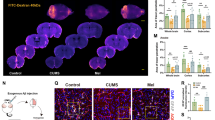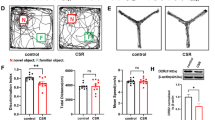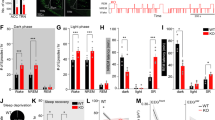Abstract
Chronic loss of sleep damages health and disturbs the quality of life. Long-lasting sleep deprivation (SD) as well as sleep abnormalities are substantial risk factors for major depressive disorder, although the underlying mechanisms are not clear. Here, we showed that chronic SD in mice promotes a gradual elevation of extracellular ATP, which activates astroglial P2X7 receptors (P2X7Rs). Activated P2X7Rs, in turn, selectively down-regulated the expression of 5-HT2B receptors (5-HT2BRs) in astrocytes. Stimulation of P2X7Rs induced by SD selectively suppressed the phosphorylation of AKT and FoxO3a in astrocytes, but not in neurons. The over-expression of FoxO3a in astrocytes inhibited the expression of 5-HT2BRs. Down-regulation of 5-HT2BsRs instigated by SD suppressed the activation of STAT3 and relieved the inhibition of Ca2+-dependent phospholipase A2. This latter cascade promoted the release of arachidonic acid and prostaglandin E2. The depression-like behaviors induced by SD were alleviated in P2X7R-KO mice. Our study reveals the mechanism underlying chronic SD-induced depression-like behaviors and suggests 5-HT2BRs as a key target for exploring therapeutic strategies aimed at the depression evoked by sleep disorders.






Similar content being viewed by others
References
Alvaro PK, Roberts RM, Harris JK, Bruni O. The direction of the relationship between symptoms of insomnia and psychiatric disorders in adolescents. J Affect Disord 2017, 207: 167–174.
Goldstein AN, Walker MP. The role of sleep in emotional brain function. Annu Rev Clin Psychol 2014, 10: 679–708.
Li X, Liang S, Li Z, Li S, Xia M, Verkhratsky A, et al. Leptin increases expression of 5-HT2B receptors in astrocytes thus enhancing action of fluoxetine on the depressive behavior induced by sleep deprivation. Front Psychiatry 2018, 9: 734.
Xia M, Li X, Yang L, Ren J, Sun G, Qi S, et al. The ameliorative effect of fluoxetine on neuroinflammation induced by sleep deprivation. J Neurochem 2018, 146: 63–75.
Chennaoui M, Arnal PJ, Drogou C, Leger D, Sauvet F, Gomez-Merino D. Leukocyte expression of type 1 and type 2 purinergic receptors and pro-inflammatory cytokines during total sleep deprivation and/or sleep extension in healthy subjects. Front Neurosci 2017, 11: 240.
Illes P, Verkhratsky A, Burnstock G, Franke H. P2X receptors and their roles in astroglia in the central and peripheral nervous system. Neuroscientist 2012, 18: 422–438.
Backlund L, Lavebratt C, Frisén L, Nikamo P, Hukic Sudic D, Träskman-Bendz L, et al. P2RX7: expression responds to sleep deprivation and associates with rapid cycling in bipolar disorder type 1. PLoS One 2012, 7: e43057.
Li B, Zhang S, Li M, Hertz L, Peng L. Chronic treatment of astrocytes with therapeutically relevant fluoxetine concentrations enhances cPLA2 expression secondary to 5-HT2B-induced, transactivation-mediated ERK1/2 phosphorylation. Psychopharmacology (Berl) 2009, 207: 1–12.
Peng L, Song D, Li B, Verkhratsky A. Astroglial 5-HT2B receptor in mood disorders. Expert Rev Neurother 2018, 30: 1–8.
Qian Y, Cao Y, Deng B, Yang G, Li J, Xu R, et al. Sleep homeostasis regulated by 5HT2b receptor in a small subset of neurons in the dorsal fan-shaped body of drosophila. Elife 2017, 6: e26519.
Li B, Zhang S, Li M, Hertz L, Peng L. Serotonin increases ERK1/2 phosphorylation in astrocytes by stimulation of 5-HT2B and 5-HT2C receptors. Neurochem Int 2010, 57: 432–439.
Xia M, Zhu Y. Signaling pathways of ATP-induced PGE2 release in spinal cord astrocytes are EGFR transactivation-dependent. Glia 2011, 59: 664–674.
Yue N, Huang H, Zhu X, Han Q, Wang Y, Li B, et al. Activation of P2X7 receptor and NLRP3 inflammasome assembly in hippocampal glial cells mediates chronic stress-induced depressive-like behaviors. J Neuroinflammation 2017, 14: 102.
Kim JE, Ko AR, Hyun HW, Min SJ, Kang TC. P2RX7-MAPK1/2-SP1 axis inhibits MTOR independent HSPB1-mediated astroglial autophagy. Cell Death Dis 2018, 9: 546.
Polter A, Yang S, Zmijewska AA, van Groen T, Paik JH, Depinho RA, et al. Forkhead box, class O transcription factors in brain: regulation and behavioral manifestation. Biol Psychiatry 2009; 65, 150–159.
Xia M, Yang L, Sun G, Qi S, Li B. Mechanism of depression as a risk factor in the development of Alzheimer’s disease: the function of AQP4 and the glymphatic system. Psychopharmacology (Berl) 2017, 234: 365–379.
Franken P, Dijk DJ, Tobler I, Borbély AA. Sleep deprivation in rats: effects on EEG power spectra, vigilance states, and cortical temperature. Am J Physiol 1991, 261: R198–R208.
Cao X, Li LP, Wang Q, Wu Q, Hu HH, Zhang M, et al. Astrocyte-derived ATP modulates depressive-like behaviors. Nat Med 2013, 19: 773–777.
Lundin A, Thore A. Analytical information obtainable by evaluation of the time course of firefly bioluminescence in the assay of ATP. Anal Biochem 1975, 66: 47–63.
McElroy WD, DeLuca MA. Firefly and bacterial luminescence: basic science and applications. J Appl Biochem 1983, 5: 197–209.
Fu H, Li B, Hertz L, Peng L. Contributions in astrocytes of SMIT1/2 and HMIT to myo-inositol uptake at different concentrations and pH. Neurochem Int 2012, 61: 187–194.
Li B, Zhang S, Zhang H, Hertz L, Peng L. Fluoxetine affects GluK2 editing, glutamate-evoked Ca(2 +) influx and extracellular signal-regulated kinase phosphorylation in mouse astrocytes. J Psychiatry Neurosci 2011, 36: 322–338.
Li B, Zhang S, Zhang H, Nu W, Cai L, Hertz L, et al. Fluoxetine-mediated 5-HT2B receptor stimulation in astrocytes causes EGF receptor transactivation and ERK phosphorylation. Psychopharmacology (Berl) 2008, 201: 443–458.
Li B, Qi S, Sun G, Yang L, Han J, Zhu Y, et al. Leptin suppresses adenosine triphosphate-induced impairment of spinal cord astrocytes. J Neurosci Res 2016, 94: 924–935.
Ren J, Li X, Sun G, Li S, Liang S, Li Z, et al. Protective effect of leptin-mediated caveolin-1 expression on neurons after spinal cord injury. Cell Calcium 2018, 76: 122–128.
Xia M, Zhu Y. FOXO3a involvement in the release of TNF-α stimulated by ATP in spinal cord astrocytes. J Mol Neurosci 2013, 51: 792–804.
Xia M, Zhu Y. Fibronectin enhances spinal cord astrocyte proliferation by elevating P2Y1 receptor expression. J Neurosci Res 2014, 92: 1078–1090.
Li D, Luo L, Xu M, Wu J, Chen L, Li J, et al. AMPK activates FOXO3a and promotes neuronal apoptosis in the developing rat brain during the early phase after hypoxia-ischemia. Brain Res Bull 2017, 132: 1–9.
Zhou J, Zhang X, Zhou Y, Wu B, Tan ZY. Up-regulation of P2X7 Receptors Contributes to Spinal Microglial Activation and the Development of Pain Induced by BmK-I. Neurosci Bull 2019, 35: 624–636.
Iwata M, Ota KT, Li XY, Sakaue F, Li N, Dutheil S, et al. Psychological stress activates the inflammasome via release of adenosine triphosphate and stimulation of the purinergic type 2X7 receptor. Biol Psychiatry 2016, 80: 12–22.
Krueger JM, Huang YH, Rector DM, Buysse DJ. Sleep: a synchrony of cell activity-driven small network states. Eur J Neurosci 2013, 38: 2199–2209.
Peng L, Gu L, Li B, Hertz L. Fluoxetine and all other SSRIs are 5-HT2B agonists - Importance for their therapeutic effects. Curr Neuropharmacol 2014, 12: 365–379.
He Y, Taylor N, Fourgeaud L, Bhattacharya A. The role of microglial P2X7: modulation of cell death and cytokine release. J Neuroinflammation 2017, 14: 135.
Ortega F, Pérez-Sen R, Delicado EG, Miras-Portugal MT. P2X7 nucleotide receptor is coupled to GSK-3 inhibition and neuroprotection in cerebellar granule neurons. Neurotox Res 2009, 15: 193–204.
Sundler R, Winstedt D, Wijkander J. Acyl-chain selectivity of the 85-kDa phospholipase A2 and of the release process in intact macrophages. Biochem J 1994, 15: 455–458.
Dennis EA, Cao J, Hsu Y, Magrioti V, Kokotos G. Phospholipase A2 enzymes: physical structure, biological function, disease implication, chemical inhibition, and therapeutic intervention. Chem Rev 2011, 111: 6130–6185.
Kalinski P. Regulation of immune responses by prostaglandin E2. J Immunol 2012, 188: 21–28.
Gałecki P, Florkowski A, Bieńkiewicz M, Szemraj J. Functional polymorphism of cyclooxygenase-2 gene (G-765C) in depressive patients. Neuropsychobiology 2010, 62: 116–120.
Pae CU, Yu HS, Kim JJ, Lee CU, Lee SJ, Lee KU, et al. BanI polymorphism of the cytosolic phospholipase A2 gene and mood disorders in the Korean population. Neuropsychobiology 2004, 49: 185–188.
Müller N. COX-2 inhibitors as antidepressants and antipsychotics: clinical evidence. Curr Opin Investig Drugs 2010, 11: 31–42.
Acknowledgements
This work was supported by the National Natural Science Foundation of China (81871852, 81200935, 81671862, and 81871529), Liaoning Revitalization Talents Program (XLYC1807137), the Scientific Research Foundation for Overseas Scholars of the Education Ministry of China (20151098), and the Natural Science Foundation of Liaoning Province, China (20170541030).
Author information
Authors and Affiliations
Corresponding authors
Ethics declarations
Conflict of interest
The authors report no financial interests or potential conflicts of interest.
Rights and permissions
About this article
Cite this article
Xia, M., Li, Z., Li, S. et al. Sleep Deprivation Selectively Down-Regulates Astrocytic 5-HT2B Receptors and Triggers Depressive-Like Behaviors via Stimulating P2X7 Receptors in Mice. Neurosci. Bull. 36, 1259–1270 (2020). https://doi.org/10.1007/s12264-020-00524-4
Received:
Accepted:
Published:
Issue Date:
DOI: https://doi.org/10.1007/s12264-020-00524-4




